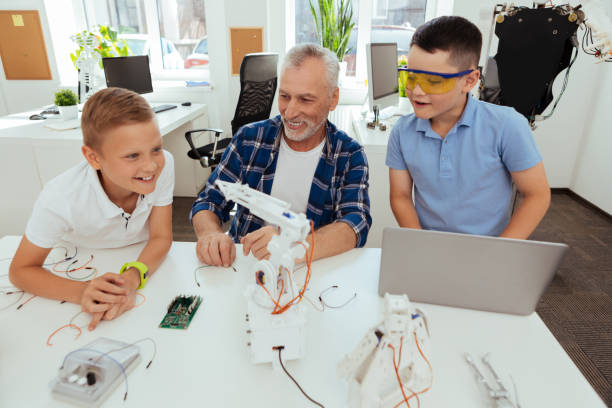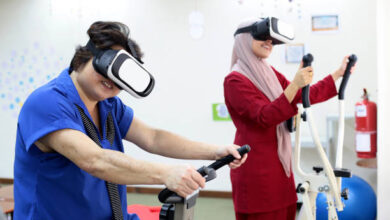From Classroom to Virtual Adapting to Education Technology in Today’s World
EDUCATION TECHNOLOGY

Technology has transformed the way we live, work, and learn in the 21st century. In the field of education, technology has revolutionized traditional teaching methods and opened up new opportunities for students and teachers alike. As we continue to navigate through a global pandemic, the use of educational technology has become more crucial than ever before. From online classes to virtual learning platforms, education technology has allowed us to adapt and continue our academic pursuits in the midst of challenging times. In this blog post, we will explore the benefits and challenges of utilizing technology in education and how it is shaping the future of learning in today’s world.
Understanding the Concept of Educational Technology
Education technology, also known as EdTech, refers to the use of technology to enhance and facilitate learning in educational settings. It encompasses a wide range of tools and resources, such as online learning platforms, virtual reality, mobile apps, and educational software. The goal of educational technology is to improve the educational experience for students, making it more interactive, engaging, and accessible.
Educational technology is not just limited to the use of computers or digital devices in the classroom. It also includes the integration of technology into curriculum design, instructional strategies, and assessment methods. For example, teachers can use educational software to create interactive lessons, students can collaborate on projects using online platforms, and assessments can be administered online.
The concept of educational technology has gained significant traction in recent years due to the rapid advancements in technology and its increasing importance in our daily lives. It has the potential to transform traditional teaching methods and provide personalized learning experiences for students. With the help of educational technology, students can learn at their own pace, access a wide range of resources and materials, and engage in interactive and immersive learning experiences.
However, it is important to note that educational technology is not a substitute for good teaching. It is a tool that can enhance and support effective instruction. Teachers still play a vital role in guiding and facilitating student learning, even in the digital age. Additionally, the integration of educational technology requires proper planning, training, and support for both teachers and students to ensure its successful implementation.

Exploring the Benefits and Challenges of Virtual Learning
In today’s world, virtual learning has become an essential part of education. The benefits of virtual learning are plentiful, starting with its accessibility. Students can access educational materials and resources from anywhere in the world, as long as they have an internet connection. This opens up a world of opportunities for students who may not have access to traditional educational settings.
Virtual learning also promotes flexibility in scheduling. Students can learn at their own pace, allowing them to balance their academic pursuits with other commitments, such as work or family responsibilities. Additionally, virtual learning provides a personalized learning experience. Students can choose the subjects and courses that interest them and delve deeper into those topics.
Another benefit of virtual learning is the ability to engage with a diverse range of learners. Students have the opportunity to collaborate with peers from different backgrounds and cultures, expanding their knowledge and perspective. Virtual learning platforms also offer interactive and immersive experiences, making the learning process more engaging and enjoyable.
However, virtual learning does come with its own set of challenges. In a traditional classroom setting, students have the opportunity to engage in discussions, ask questions, and receive immediate feedback from their teachers. Virtual learning may require students to adapt to new communication methods, such as online forums or video conferencing, which may not offer the same level of interaction.
Another challenge is the potential for technical issues. Students may encounter difficulties with internet connectivity, access to devices, or navigating through online platforms. This can hinder their learning experience and create frustration.

Adapting to the Shift from Traditional Classroom to Virtual Learning
As the world rapidly shifts from traditional classroom settings to virtual learning environments, both students and teachers are faced with the challenge of adapting to this new way of education. The transition from face-to-face interactions to online platforms can be overwhelming, but with the right strategies and support, it can also be an opportunity for growth and innovation.
One of the key aspects of adapting to virtual learning is developing new digital literacy skills. Students and teachers must become proficient in using online platforms, navigating through virtual classrooms, and effectively utilizing educational technology tools. This includes learning how to effectively communicate through online forums, participate in virtual discussions, and submit assignments electronically.
Teachers play a crucial role in guiding their students through this transition. They must not only be knowledgeable about the technology and online tools but also be able to effectively deliver their lessons and engage students in a virtual environment. This may require additional training and support to ensure that teachers are equipped with the necessary skills and resources to succeed.
Students, on the other hand, need to be self-motivated and disciplined in their approach to virtual learning. They must learn how to manage their time effectively, stay organized, and take responsibility for their own learning. It is important for students to establish a dedicated workspace, minimize distractions, and establish a routine that supports their online learning journey.
While the shift to virtual learning may present initial challenges, it also offers several benefits. Students have the opportunity to develop independent learning skills, take ownership of their education, and engage in self-paced learning. Virtual learning also provides the flexibility to tailor learning experiences to individual needs, allowing students to explore topics of interest and pursue personalized educational goals.

Technological Tools Enhancing Modern Education
In today’s digital age, technology has become an integral part of modern education, revolutionizing the way we teach and learn. Educational technology has brought forth a multitude of tools and resources that enhance the learning experience, making it more interactive, engaging, and effective.
One of the key technological tools enhancing modern education is online learning platforms. These platforms provide students with access to a vast array of educational materials and resources at their fingertips. From interactive lessons to multimedia presentations, online learning platforms offer a dynamic and immersive learning experience that can cater to individual learning styles and preferences.
Another technological tool that has transformed education is mobile apps. With the proliferation of smartphones and tablets, mobile apps have made learning more accessible and convenient. Students can now access educational content on the go, enabling them to continue their learning journey outside of the traditional classroom setting. From language learning apps to virtual flashcards, mobile apps provide a personalized and interactive learning experience.
Furthermore, virtual reality (VR) and augmented reality (AR) have emerged as powerful tools in modern education. VR and AR technologies offer students the opportunity to engage in immersive and interactive learning experiences, allowing them to explore virtual worlds, simulate real-life scenarios, and gain a deeper understanding of complex concepts. From virtual field trips to interactive science experiments, VR and AR are revolutionizing the way we learn and comprehend information.

Future Prospects of Educational Technology
As we continue to advance in the digital age, the future prospects of educational technology are boundless. With rapid technological advancements, educational technology will continue to play a pivotal role in transforming the way we teach and learn.
One of the key future prospects of educational technology is the integration of artificial intelligence (AI) and machine learning. AI has the potential to personalize learning experiences even further by analyzing student data and adapting instructional content to meet individual needs. Machine learning algorithms can identify patterns and make recommendations for personalized learning pathways, helping students maximize their potential.
Virtual reality (VR) and augmented reality (AR) are also poised to revolutionize education in the future. These immersive technologies offer unparalleled opportunities for experiential learning. Students can explore historical landmarks, simulate science experiments, or travel to outer space – all from the comfort of their classroom. By bringing learning to life through VR and AR, students can develop a deeper understanding and engage in hands-on experiences that were previously unimaginable.

Additionally, the future of educational technology includes advancements in collaborative learning platforms. With the rise of remote and online learning, students will have even more opportunities to connect and collaborate with peers from around the world. Virtual classrooms will become interactive hubs where students can engage in discussions, work on projects together, and learn from one another’s perspectives. This collaborative learning environment will foster critical thinking, problem-solving skills, and global awareness.
Furthermore, the future prospects of educational technology also encompass the use of analytics and data-driven decision-making. By collecting and analyzing data on student performance, engagement, and preferences, educators can make informed decisions about instructional strategies, curriculum design, and interventions. Data-driven insights will allow for continuous improvement in teaching practices, ensuring that every student has access to a high-quality education tailored to their individual needs.




sit quia et rerum quae aut. odit quis provident assumenda enim molestiae voluptas vel pariatur sunt est laudantium omnis nobis quae et. labore et dolore sunt modi dicta veritatis non non et ad a excepturi sed. dolores iste est dolor sapiente odit. odit inventore minus sit error non praesentium ipsam vero deleniti cumque.
est odio exercitationem quasi modi numquam in similique. culpa ipsum quod rerum ex sed voluptate nesciunt et. accusamus et optio facere accusamus occaecati quasi nam natus delectus et numquam laboriosam omnis sint. deleniti in et eaque sunt aut voluptatum dolorem aperiam doloribus. praesentium ex omnis corrupti expedita neque inventore sunt sapiente est non minus consequatur numquam quis cum.
maiores nostrum id perspiciatis qui reprehenderit aspernatur maiores dolor adipisci qui eius dolores. similique non quae numquam saepe culpa sed debitis nisi sapiente voluptate tenetur ratione id. quod quis laborum est nihil officiis ullam aut sapiente ipsam impedit voluptate aliquid.